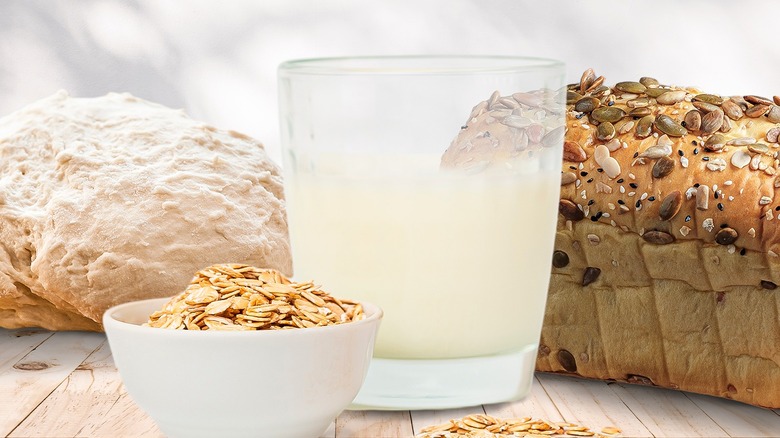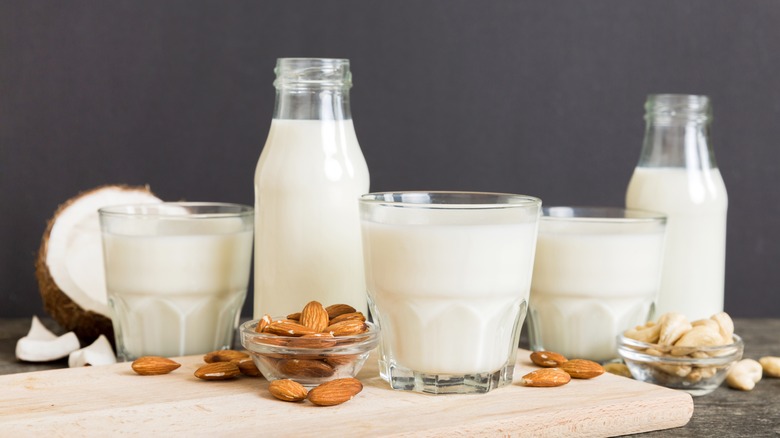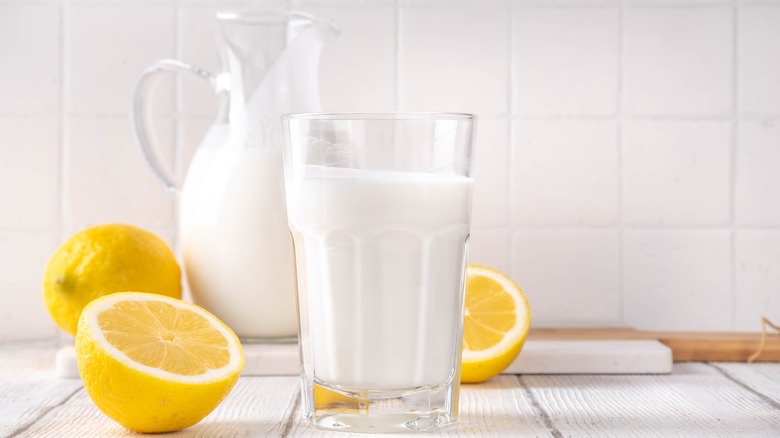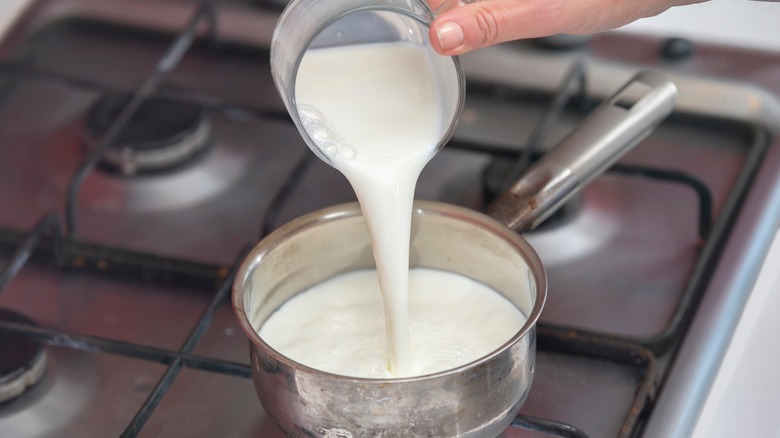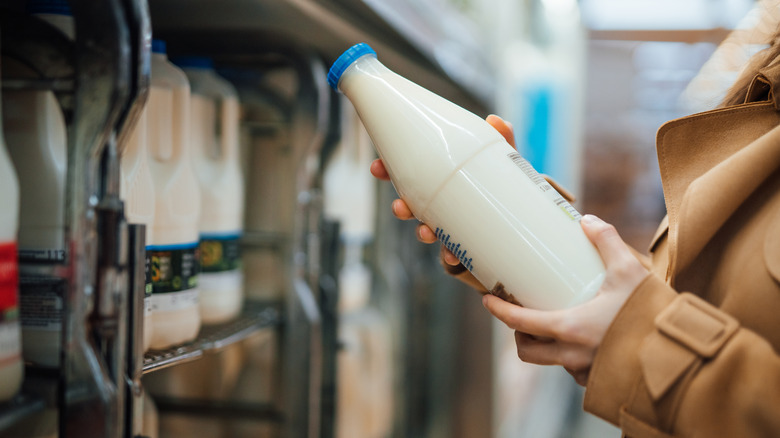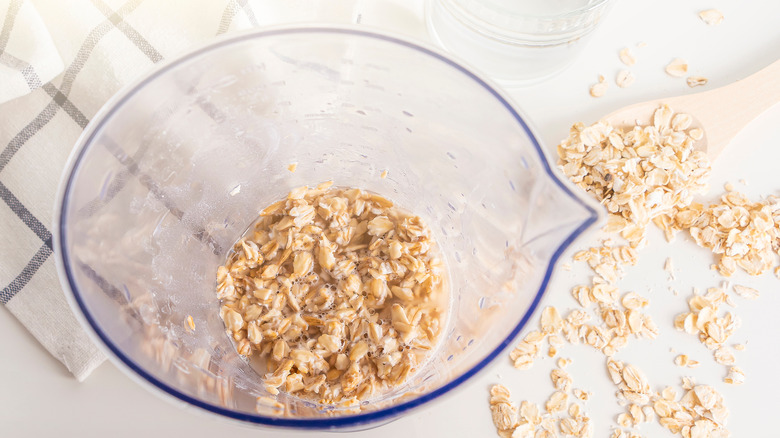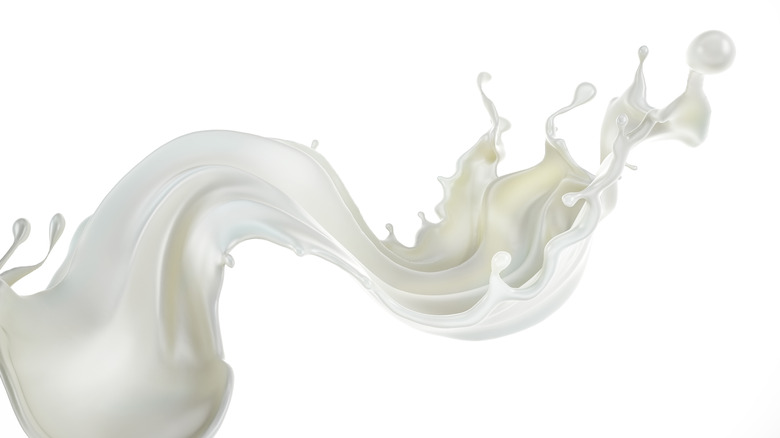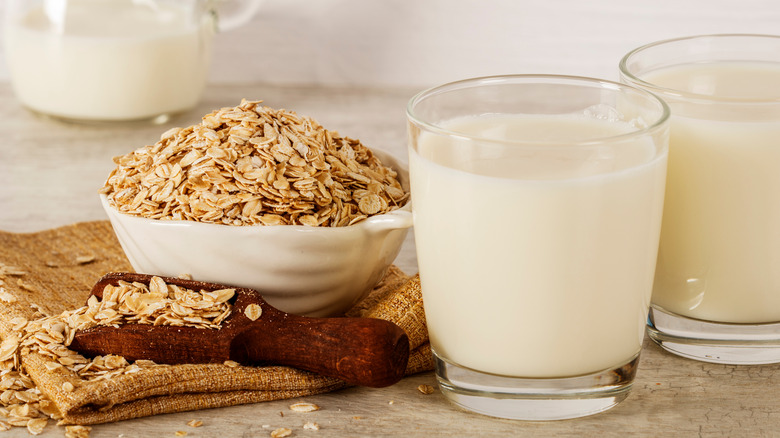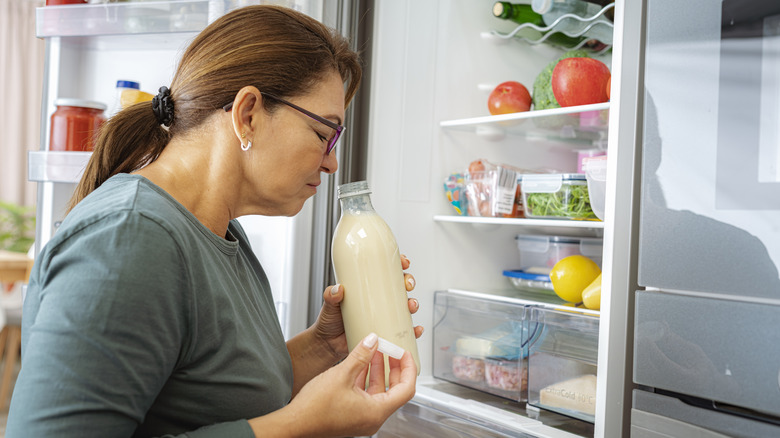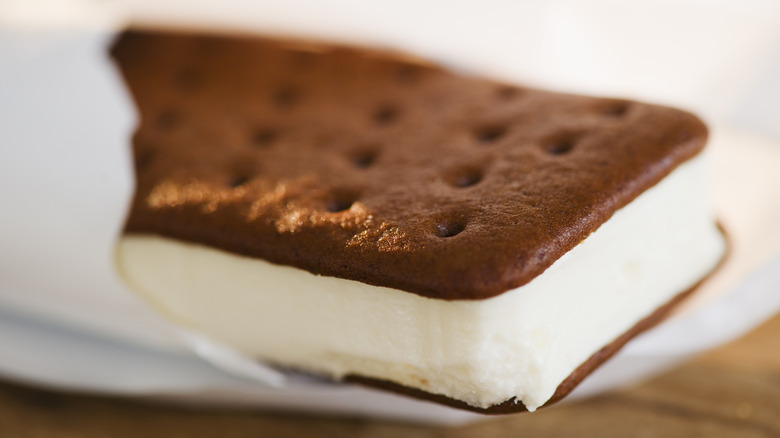10 Tips You Need When Baking With Oat Milk
When most of us think of oat milk, we imagine creamy lattes. Indeed, oat milk has had a firm grip on the U.S. market since the wildly popular Oatly brand made its American debut in 2016 and then found its way into thousands of coffee shops and grocery stores nationwide. However, many bakers have come to find that this environmentally friendly plant-based beverage is also a great ingredient to have on hand when whipping up everything from double fudge brownies to blueberry lemon Dutch babies. Bakers favor oat milk for the same reasons as baristas — it is creamy, rich, and can be used in a 1:1 ratio when substituting for cow's milk.
Having followed a mostly vegan diet since 2017, I am no stranger to oat milk. I worked with several different brands of the beverage when preparing baked goods at a bed and breakfast, and I still use it in my home kitchen. To save money and account for my occasionally ill-stocked refrigerator, I frequently blend batches of homemade oat milk, a process I'll explain later in this article. There are pros, cons, and several considerations to be mindful of when baking with oat milk. Whether it's your first time hopping on the oat milk train or you can't imagine any other alternative milk in your refrigerator, keep in mind these 10 tips for baking with oat milk the next time you fire up the oven.
1. Make sure oat milk is really the best milk alternative for your recipe
Oat milk's signature creaminess, resulting from its high particle concentration and the oils commercial brands frequently add, makes it a go-to for many bakers, but don't write off other milk alternatives quite so fast. Each milk has its own merits.
Soy milk's high protein content, which is comparable to that of cow's milk, might make it more appealing for those focused on meeting macronutrient needs. Such protein is also ideal for achieving the right structure and moisture in baking. On the other hand, some soy milks suffer from a bean-like taste. The flavor of coconut milk can likewise pervade baked goods, which is wonderful if you are making coconut macaroons but not so great if you are baking a classic vanilla birthday cake.
While I prefer oat milk's neutral taste for recipes like frosting, muffins, bread, and cornbread, I don't recommend using oat milk in recipes that rely too heavily on a high-fat content, such as whipped cream. While you may get a serviceable result, coconut milk would likely work better in such recipes, so long as you don't mind its flavor. If you opt for homemade oat milk, use the same hack as you would to create barista-worthy oat milk at home: Add a bit of oil.
When in doubt, use the kind of milk your recipe calls for because that is the way it has been tested.
2. Give oat milk enough time to curdle when making buttermilk
Whether it's your grandmother's biscuit recipe or a banana bread you can't get enough of, buttermilk is essential to many baked goods. Traditionally, buttermilk was a derivative of the butter-making process (hence its name), and while you can still occasionally source buttermilk that has been fermented at room temperature, most buttermilk in the West is now carefully cultured to ensure there is no chance of it going sour before being packed in a carton. But what if you don't have buttermilk when the baking itch knocks at your door?
The two-ingredient buttermilk replacement you should know for cow's milk is the same for oat milk: Mix one cup of oat milk with one tablespoon of an acidic ingredient like citrus juice or apple cider vinegar. The key is to allow the oat milk enough time to curdle. It takes about 10 minutes, but I always go by appearance rather than time. Because I tend to get impatient, I start curdling my oat milk when I'm preheating my oven and whisking flax eggs.
However short on time you are, don't be fooled into thinking you can substitute plain oat milk for buttermilk; buttermilk's acids lend a subtle tart flavor to baked goods, and they are also responsible for helping baked goods rise and develop a tender crumb. If your recipe calls for whole-fat buttermilk, incorporate additional oil, especially when using thinner oat milk.
3. Prevent accidental curdling
As incredible as buttermilk is, not every recipe is built for it, so don't curdle oat milk when it's not asked for. However, sometimes it happens accidentally.
If you don't want to embark on a chemistry experiment, follow a few simple rules to prevent your oat milk from curdling. First, be mindful of recipes that involve heating milk. Alternative milks are especially susceptible to curdling and separation due to protein breaking down from temperature and pH changes. This process can happen in a matter of seconds when working with acidic ingredients — for instance, when adding milk to a cup of tea or coffee. Several times, I have dutifully minded a simmering pot, whisking constantly as instructed, only to feel my heart sink into my stomach when I see the tell-tale signs of curdling.
To prevent oat milk from betraying you, there are a few steps to take. First, strive to mix liquids at the same temperature when possible; for example, allow coffee to cool before mixing it into the batter of your espresso cheesecake. Secondly, use fresh oat milk; when I bake with homemade oat milk, I find it curdles faster after sitting in the refrigerator for a day or two. Finally, opting for barista style oat milk, which consists of added fat to make it easier to steam, foam, and stretch, may save you from heartbreak because they typically include additives specifically selected to prevent curdling. For instance, dipotassium phosphate is included in many formulations.
4. Adjust recipes in light of additives
Additives may get a bad rap, but they are there for a reason. So long as they are not consumed excessively, those found in commercial oat milk are FDA-approved and most likely safe and not harmful for human consumption. In fact, commercial oat milk often includes fortifying vitamins and minerals; just one serving of Oatly's original oat milk provides 350 milligrams of calcium, equating to 25% of your daily needs.
Apart from nutrients, commercial oat milk usually includes acidity regulators to keep the pH level in check, as well as emulsifiers and/or stabilizers to keep oils and liquids from separating. These include dipotassium phosphate, guar gum, gellan gum, and xanthan gum. Choosing an oat milk with such ingredients can bring regularity to your baking. They help retain the textural integrity of oat milk, enabling you to mimic the creaminess of cow's milk without fear of uneven consistency. You'll appreciate them when making biscuits, pie crusts, and other recipes where you don't want to overwork the dough because you won't need to make multiple adjustments to account for a surprisingly watery pour.
If you really want to avoid all emulsifiers, try Oatsome's oat milk; while it does include sunflower oil and a few added vitamins and minerals, its streamlined ingredients list helped earn it a place on our list of the best oat milk brands. Just make sure to shake it thoroughly and add more oil as needed to bring its thickness up to par.
5. Avoid using oat milk products with added sugar
Although oat milk's relatively high glycemic index — a score that accounts for how quickly and how much a specific food spikes glucose levels — is the scientific reason some people are calling oat milk a scam, it is generally not a concern when baking.
The presence of added sugar is more relevant to the world of baking, and oat milk products with added sugars should especially be avoided in savory recipes. Oats are naturally sweet on their own, rendering sweetened oat milk unnecessary and even undesirable in recipes where its flavors are not masked by other ingredients. After all, nobody wants a sugary quiche.
If all you have on hand is sweetened oat milk, don't give up: You can add other ingredients or adjust the proportions of existing ones to balance out the additional sweetness. Think tangy, sour, spicy, salty, and bitter. It may not be intuitive to add these flavors to desserts, but they are responsible for how salted chocolate chip cookies and Mexican chocolate cake taste so exquisite. You can also use slightly less sugar or sweetener in recipes that call for it, but be aware that reducing the amount too much could result in textural differences.
6. Consider making your own oat milk
Making your own oat milk permits you immense flexibility regarding flavor, texture, and ingredients. If you are gluten-free, you can use gluten-free oats. If you want to avoid the herbicide glyphosate, you can use organic oats. If you want to add spices like cinnamon or cardamom, you can do that, too. I have even made strawberry oat milk, which would taste lovely in a recipe like strawberry milk cake or granola parfaits.
While flavor is important, so are finances. If you grimace every time you see a 64-ounce carton of Oatly original oat milk ringing up at around $5 to $6, you will be pleased to hear that homemade oat milk can take pressure off your wallet. Making homemade oat milk could save you $200 a year, excluding the cost of a high-speed blender, according to calculations made by Epicurious. All you need is rolled oats and water.
Recipes and tips for making homemade oat milk are highly variable, and most concern themselves with getting around the possibility of slimy milk. I favor the guide provided by Britt Berlin on The Banana Diaries blog. Berlin stresses not soaking your oats, asks you to use ice-cold water, and recommends blending for the shortest amount of time possible. She also suggests that you avoid vigorously squeezing oat milk while straining, a deviation from the standard practice for nut milk, and that you double strain your milk. I stand by all these tips.
7. Shake, shake, shake
If you notice particles at the bottom of a jar of homemade oat milk, don't immediately assume it's curdling. If your oat milk was made in the last day or two, it is more likely that these particles are just tiny bits of oats that have naturally settled over time. If you are using commercial oat milk that is packaged in an opaque carton, you won't see these particles and might ignore the directions that say to shake well before pouring. Whatever you do, do not ignore these directions!
Imagine not stirring a jar of natural peanut butter and scooping only liquid from the top. Its taste and texture would be off, and its altered composition would be quite evident in your recipes. The same is true for oat milk; if you fail to shake, you will first end up with a watery consistency lacking in flavor and creaminess and then have to deal with a thick dredge of oat particles as your carton nears empty.
When making homemade oat milk, I mitigate the number of particles by popping the blender into the refrigerator after the first whirl and allowing settling to occur before carefully straining. I stop pouring when the particle concentration significantly rises, then use the remainder in smoothies or oatmeal. This helps expedite the milking process and keeps it slightly less messy. However, this still doesn't get you off the hook with shaking; you'll need to work those arm muscles, albeit a little less.
8. Use full-fat oat milk in place of whole milk
You might be familiar with Oatly's low-fat oat milk, unsweetened oat milk, and "super basic" oat milk varieties. They forgo the canola oil that is present in the brand's other milks and, therefore, contain only 1 gram, 1.5 grams, and 1 gram of fat per serving, respectively. Compare this to Oatly's full-fat oat milk (9 grams of fat), its original oat milk (5 grams), and its barista oat milk (7 grams). All these options can seem overwhelming, but when it comes to baking, the answer is simple: Use full-fat, especially when that is what the recipe calls for or when you are substituting whole milk.
Going full-fat is one of the best oat milk tips to follow when making vegan baked goods because its viscosity is close to that of cow's milk. There are 8 grams of fat per serving of whole milk, and this fat is essential to a tender crumb and indulgent flavor. When making decadent treats like cheesecakes, custard pastries, pies, and chocolate cakes, don't fear the fat found in oat milk, which is often unsaturated. Spread out over an entire recipe, it won't amount to much, and unless you are consuming a full carton of it every day, you will probably be just fine.
9. Perform a sniff test before each pour
More times than I'd like to admit, I've poured a cup of oat milk only to wrinkle my nose upon finding that it's gone rancid. Whether you are using homemade or commercial oat milk, be aware of its shelf life and always sniff prior to pouring.
Commercial oat milk can stay viable for quite a while before you break the seal; Oatly's chilled beverages have an average shelf life of two months, and its ambient drinks stay good for about one year. However, the brand recommends finishing off a carton within five days of opening it. Pacific Foods' organic oat milk has a slightly more generous timeframe of seven to 10 days. I find that homemade oat milk is best used within three to five days.
As they say, time is relative, and other variables are always at play, such as where you store your oat milk in the fridge (hint: The bottom shelf at the very back is ideal). That's why you should know how to tell if oat milk has gone bad. If you sense your oat milk is nearing the end of its life, use it up in a bread pudding, freeze it, or take advantage of its creaminess in protein shakes, smoothies, or milkshakes. And luckily, unlike almond milk, oat milk does not require any advanced preparation, making it easy to blend another batch and persevere with your recipe.
10. Experiment with other oat-milk-based products
These days, you can find oat-milk-based condensed milk, yogurts, ice creams, and cream cheeses. Such alternative products make recipe modifications a breeze. I am always thankful for them when it comes to baking my great-grandmother's recipes, which were not designed for vegans in the slightest.
I suggest taking advantage of oat-milk-based condensed milk when making pumpkin pies, trifles, and macaroons. Love ice cream, but your stomach can't get on board with dairy? Buy a carton of oat milk ice cream and replicate Trader Joe's oat milk ice cream sandwiches with your own baked cookies.
Cultured oat milk products like oat-milk-based yogurt are fantastic for cakes, pancakes, breads, and muffins. Meanwhile, oat-milk-based cream cheese is not only meant for cheesecakes; it is likewise delightful in Danishes and puff pastries.
Finally, consider keeping a package of powdered oat milk on hand as a shelf-stable backup; even the best of us often run out in the middle of a marathon baking session!
